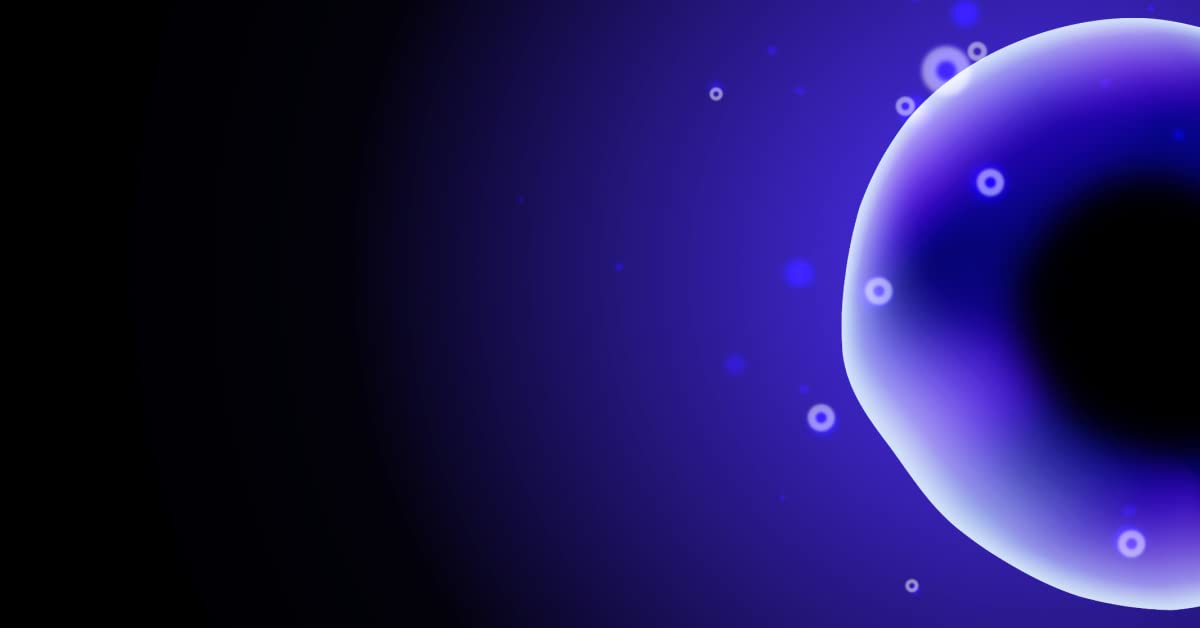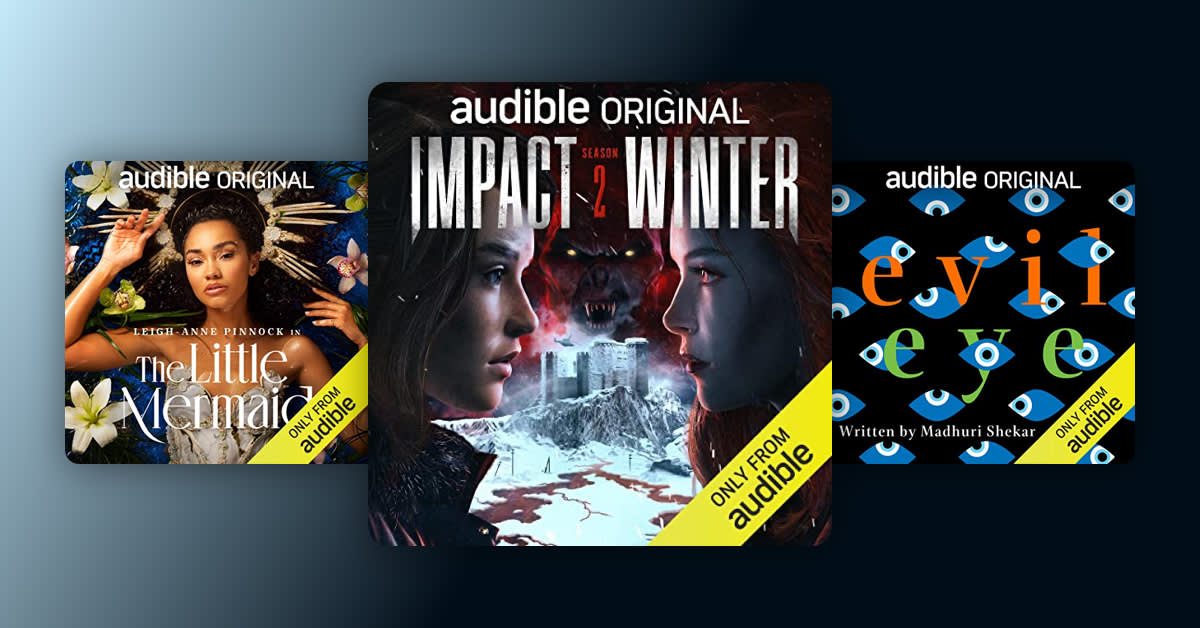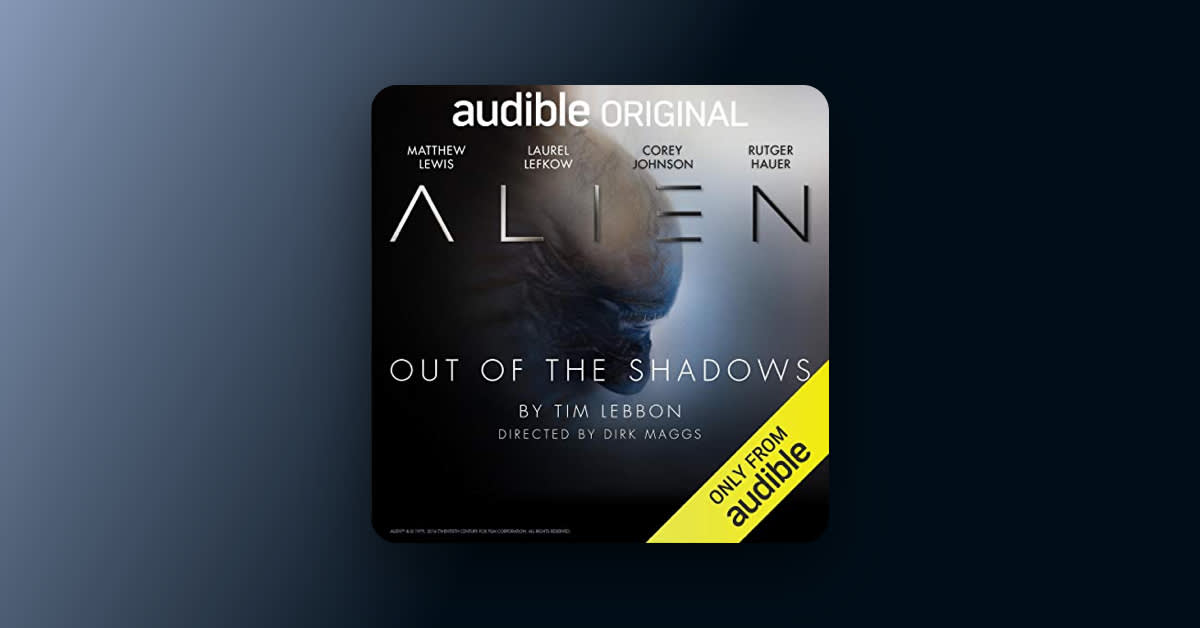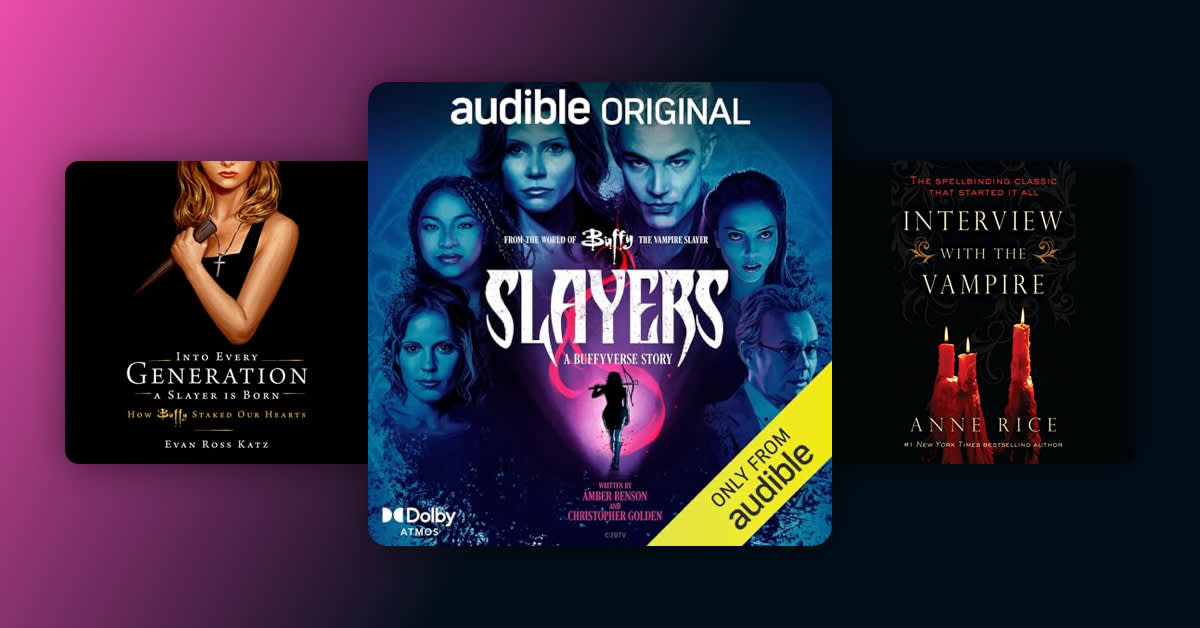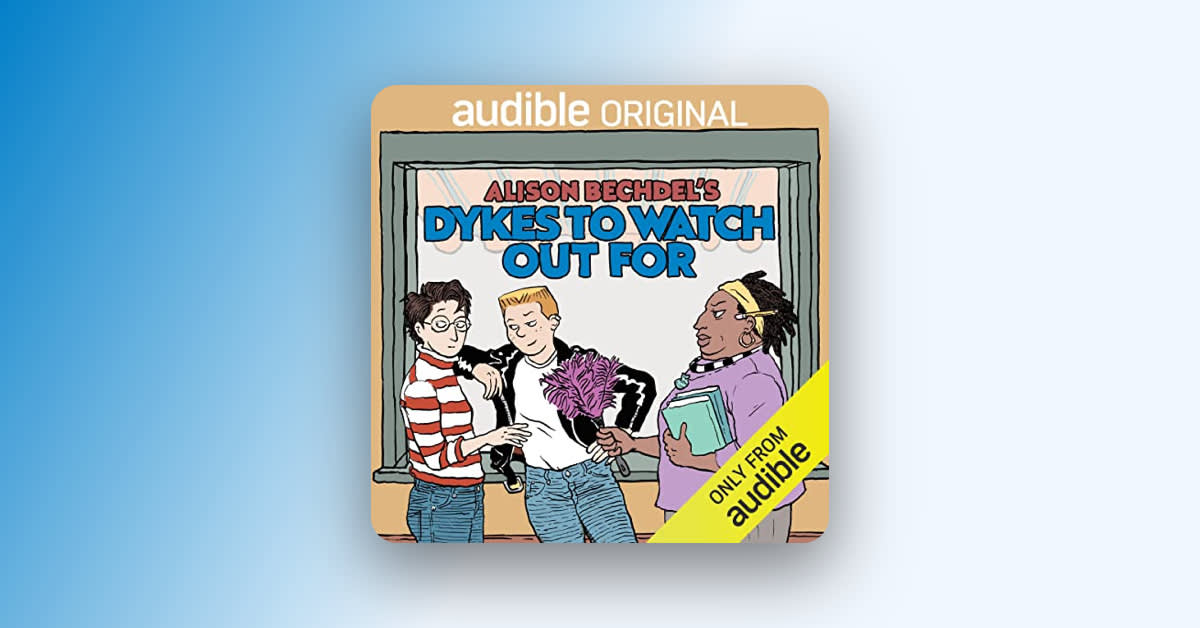Note: The following is an edited transcription of Stories in 360 Degrees, an audio essay featuring conversations with sound design and production experts as well as samples from selected Audible productions available in Dolby Atmos. Text has been edited and does not match audio exactly.
Sam Danis:
Hi, I'm Sam Danis. I'm an editor here at Audible where specifically I focus on sci-fi and fantasy. I have a confession. Even though I'm an audio entertainment nerd and avid listener, I am not what you might call an audiophile. My earbuds are rarely the newest model, I don't have a home theater setup, and sometimes—and I'm sort of embarrassed to admit this—I just listen on my phone speakers.
While I love original productions with sound design, I don't necessarily listen for production value as much as I listen for story: to get swept away in a world created by authors I admire, performed by some of my favorite voices. But something's been changing within the past year. I've listened to a few productions that, for me, up the ante of what audio storytelling could accomplish. Take, for instance, the new Audible Original adaptation of 1984.

"This is Big Brother..."
Clip from "1984"
SD: This is an example of a title mixed in Dolby Atmos. It sounds pretty amazing, right? And it's only one of dozens of titles you can now listen to with Dolby Atmos. I was really curious about how a production like this comes together, what kind of special considerations go into it, and what exactly spacial audio is. And I thought you, our listeners, might be curious as well. So, join me as we dive in.
I first reached out to Kat Lambrix, who oversees production for Audible titles.
Kat Lambrix: What that means is that I manage a team of really amazing producers. I get to work with the creative development folks on the projects that are coming into us. I get to be in the studio and manage our onsite studios, and then I get to work with our fantastic post team on sound design and music for all of our projects.
SD: I love talking to Kat. She's worked here for many, many years and has such an infectious enthusiasm about what she does.
KL: One of the things as a kid with books that I loved so much was that I got to use my imagination, right? I got to picture in my head, you know, what did Boo Radley look like? What did the trees in Narnia look like to me? And with Dolby Atmos, as a listener, for me, it helps me put myself in that scene and continue to use my imagination to make it look like what I want it to look like.
SD: And I think that gets at the heart of why we listen, right? To live in these worlds. And with Dolby Atmos, there's a whole new way to achieve that immersion.
KL: Being able to work in 360 degrees has let us tell stories in a different way. It lets us really give the listener an immersive experience. How are they experiencing this story and how can we help them move through it in a way that really honors the author and the creator's vision? So, now, instead of having a very sort of didactic, "Oh, there are footsteps over on the left," we can have footsteps sort of quietly walking through a room to demonstrate that a character walked past, or we can put people in a setting which really helps to create an environment and really helps to immerse listeners. So, for instance, in Dykes to Watch Out For, there are a lot of places in that project that are really important, and we were able to create a room to put a listener in as they're experiencing the scene. So, they're not being told what happens. They're really getting to be a part of what happens.
SD: Dykes to Watch Out For is an Audible Original based on Alison Bechdel's iconic comic strip. I love the idea of getting to be a part of what happens, which is so true of this piece because it actually made use of historic audio, dropping listeners alongside the characters right into the crowd of the March on Washington for Lesbian and Gay Rights in 1987.

Experiencing the 1987 March on Washington for Lesbian and Gay Rights
"Dykes to Watch Out For" clip
SD: But backing up a bit. What exactly is spatial audio?
Curtis Macdonald: There's a number of terms that are synonymous with spatial audio. 3D audio, immersive audio. And all it is is surround sound on steroids a bit.
SD: That's Curtis Macdonald, a sound designer here at Audible.
CM: Usually I'm the last responder to a show and I take the raw materials and I turn them into a finished, polished product, adding as much production value as possible.
SD: He's worked on a variety of Dolby Atmos titles here, and his description of surround sound on steroids isn't wrong. Kat explains.
KL: When you've got stereo, it's coming from two points, typically a right/left. But when we're talking about immersive audio and Dolby Atmos, the technology allows for the sounds to be placed in 360 degrees around you as a listener. So, it's no longer right/left. It's top/bottom. It's front/back and it's also size, so we can make sounds be larger or smaller depending on the need.
SD: Okay. So, let's get really nerdy about it for a second. First, we have mono. It's a basic format where sound is coming from a single source, no effects. Then we have stereo. This is the most common format. Sound is coming from two sources creating a realistic left to right experience. Then we have binaural. This is an enhanced format that gives the illusion of surround sound. And, finally, we have Dolby Atmos, a spatial audio format that delivers immersive sound coming from all around you. So, with Atmos, titles are not only near and far, they're above us, all around us, sneaking up behind us. I spoke to another sound designer here via email, and he explained that it kind of tricks your brain into thinking things are happening all around you when you wear headphones.

What is spatial audio?
The difference between mono, stereo, binaural, and spatial
CM: The minute that you design a sound that sounds further away than something else, you're designing proximity, closeness versus farness; that is a spatial effect. I would argue in its most primitive state, spatial audio is just that, the difference in perspective. Perspective is key. That is spatial audio, knowing where something is coming from or not knowing where something is coming from that makes you sort of lean into the listening experience.
SD: And therein lies the key, I think, to what makes an Atmos story so profound. It's not only an objectively cool, high-tech listening experience, it's a storytelling device. Take, for instance, something the average person might not imagine working in audio, a comic or graphic novel, like the one we talked about earlier with Kat.
KL: They're always my favorite pieces of content to work on because you have this really rich environment and it takes skill, and I'm really proud of our producers for being able to take something that is visual and translate it into audio and work with authors. We get feedback from listeners like, "Oh, I felt like I was there" or "This was a great thing to have in addition to the print book." Or "I felt like I was there in the scene with these characters who I love." And it's always an interesting experience because sometimes we work on existing IP, like Sesame Street or Dykes to Watch Out For, and other times we get something that's brand-new and being written just for audio, like Space: 1969 from Bill Oakley, or Letters from Camp.
SD: That title she mentioned, Letters from Camp, is a three-season series written by Jamie Lee Curtis and Boco Haft. It's another fantastic example of an immersive listen, this time for kids.

Off to Camp Cartwright
Clip from "Letters from Camp"
KL: And it was three seasons and we were able to really build this world. We were able to work with the creator and the author, and then also all of the actors to make this place that didn't exist before. And when I think about what I love about books, it's that there is a place that you get to go to as a reader. And now with Dolby Atmos, there is sort of this virtual place that we get to bring people to and we get to bring them into the experience, and I feel like in terms of giving folks an experience that really hits home for them and allows them to fully immerse themselves for whatever reason they're listening, right?
SD: That's not to say these productions don't come with their own unique challenges. I asked Curtis how spatial audio has impacted his creative process.
CM: Um, well [laughs], it's complicated. It was a challenge, right? We're during pandemic lockdown, quarantine. And this show is an outdoor sleepaway camp in Maine with hundreds of teenage voices in the background and in crowd situations. A huge challenge to overcome. And there was nothing scripted for crowd cheers and reactions. Like, if you're in a school, there's gonna be kids talking around you, right?
SD: Right. It's loud.
CM: It's a loud hallway experience, for example. And all the side banter that's audible in a script, if that hasn't been included and our clients and our stakeholders want that experience, then it usually falls on someone like me to design that dialogue experience. And so I scripted hundreds and hundreds of extra lines for that show, and then we recorded dozens of different people as young as possible performing variations on all these sort of walla lines, all these sort of extra lines, interactions, interjections, emotional responses.
SD: These seem like such small details, ones we might not even consciously consider while listening. But try to imagine the same scene without it, a silent summer camp. That we would notice. And thus, the amount of creative thinking and working hours that go into these productions.
CM: I was able to synthesize an immersive crowd for key scenes, and what you got was this believability of, like, okay, you're outdoors at a campfire, for instance, and there's all these different voices that you can kind of hear and a couple little words kind of peak up. It creates this sort of three-dimensional immersion of dialogue that's supporting the main characters' dialogue.
SD: I really wanted a writer's perspective on this, too. What is it like to go into an audio only project for the first time? So, I reached out to Bill Oakley, the creator of Space: 1969, another title that Kat mentioned. It's a retro, alternate-history sci-fi comedy. Bill and his partner, Josh Weinstein, were the head writers and showrunners for The Simpsons. So, Bill is no stranger to writing comedy.

JFK addresses the moon colony
Clip from "Space 1969"
Bill Oakley: So, when the show begins, it's third Inauguration Day, January 20, 1969, and we're in a universe that isn't that different than the real universe, but just slightly because we have an orbiting space station and we have a colony that's gonna open on the moon on July 4, 1969. In the midst of all this is Nurse Nancy Kranich, who is the night nurse at the infirmary on the space station. She's played by Natasha Lyonne in what I consider to be Natasha's greatest role.

Natasha Lyonne as Nurse Nancy Kranich
Clip from "Space 1969"
BO: It would cost $500 million to make this as a TV show or movie, and it's a niche. It's a triple niche. Sci-fi is a niche. Comedy's a niche. Retro is definitely a niche. That's why it's perfect for an Audible Original.
SD: I'd heard this idea from other creators we've talked to, the freedom and possibilities that an audio original offers. There are no visuals, which for sure cuts costs on special effects. But now the onus is really on the sound designers to place the listener in each scene. I asked Bill what it was like hearing the final mix of Space: 1969 for the first time.
BO: So, obviously the performances, I was there with the actors, so I had heard them already, but once they started to add in the sound effects and the world, I was actually somewhat shocked by how layered it was and how complex it was.
SD: Here's an example of one of those layered and complex scenes where JFK (yes, he has survived in this timeline) is just casually walking through the streets of DC causing absolute pandemonium.

JFK causes pandemonium
Clip from "Space 1969"
BO: Even just the general atmosphere is really carefully constructed. Like, you can tell when you're in an office. You can hear the ventilation going very quietly, and the offices have different ventilation. Maybe this is my imagination, but I know that one guy's office sounded different than another guy's office. You know, phones ringing in the background. There's all sorts of layers of stuff that are happening that makes it seem very realistic that were very carefully constructed and beyond anything I had imagined.
SD: I don't think Bill's imagining things here. So much of the comedy in this production, aside from the amazing performances, comes from the ambiance. There's a recurring bit in which the song "MacArthur Park" is constantly playing, and sometimes it's contextually to the scene, a character turning on a radio. But sometimes it's just there somewhere in the background.

The ever-present "MacArthur Park"
Clip from "Space 1969"
BO: You'd be shocked at how the difference between one sound and another results in a laugh or a joke falling flat. There's such a specificity to timing in comedy, and not just in the performance. And there's a lot of specificity in the performances of the actors in Space: 1969. But in where the sound appears, if it appears a fraction of a second too late or too early, the joke is dead.
Nathan Freeman: That fact that spatial audio has emerged in the last couple years has been a real godsend for us, because we love playing, and it just allows you to play so well.
SD: That's Nathan Freeman. He's the CEO of Granny Eats Wolf, a production company who's partnered with Audible UK on several titles, including one of my favorite listens in recent memory, and I'm not just saying that because I work here. It's the Audible Original production of 1984. It stars Andrew Garfield, Cynthia Erivo, Andrew Scott, and Tom Hardy, and features music composed by Matt Bellamy of Muse, performed by a full orchestra. It is a stacked production, and I was especially curious how one approaches something as major as this. 1984 is a classic for a reason, right? So, how do you stay true to an iconic story while also reinventing it? According to Nathan, it's all about the listener.
NF: One thing's fundamental is that when you're thinking about where to place the listener, when you're looking at a script and you're thinking, "Okay, are they gonna be with the main protagonist? Are they gonna be in the center of the scene?" Suddenly, you're really coming at it from the listener's point of view and you're not telling anyone a story. You're saying, "How can you experience a story with much more kind of heightened emotion, heightened senses?" You know, it's striking that balance between being ubercreative and wanting to have things flying around your head all the time, to being like, "Well, what serves the story best? What really serves that listener?" Because if they're not understanding it or they're struggling to hear, even though it might sound incredible in the expensive headphones I use to mix, it's sort of failing to tell a great story.
For example, where Cynthia is in the crowd and what's now known as Victory Square, which used to be Trafalgar Square in London...

Crowd scene in Victory Square
Clip from "1984"
NF: She sort of appears, and in the script originally, I think there were some footsteps and there's a busy crowd. It's loud. So, it was just knowing how to utilize spatial to put in a line just for Cynthia just to throw her voice in that scene, and it's just examples like that where we're kind of thinking about how somebody's coming into the room, where they're coming from. You just add an element of movement within the script.
SD: I know when I was first learning about Dolby Atmos, I pictured its use in these big action-oriented productions. And don't get me wrong, for those types of stories, it really shines. But what surprised me as I dug deeper is just how equally impactful it can be in those quiet, but emotionally charged moments. And according to Curtis, those are among the most important moments.
CM: I was watching a clip of Aaron Sorkin, who did The Social Network movie. And the opening scene is this bar and his girlfriend's breaking up with him.
You know, it's like this tense, amazing, emotional scene. They did 100 takes of it to get all sorts of different variations in the dialogue and the camera settings. That's what it takes, you know, to create a really great library of options that then you design, you compile the best version of itself.
SD: Some of my favorite moments in 1984, for instance, were the earliest scenes between Winston Smith and Julia as they're getting to know each other and striking up this illicit, dangerous love affair.

A dangerous love affair
Clip from "1984"
NF: Yeah, the brief was very specific. It was, I make us feel that, I make us not squirm and think this is really cheesy. Like, this is a love story. Doesn't matter what you're into, whatever your identity, you wanna be able to relate to that love, but also the naughtiness in that relationship.
SD: And there are, of course, darker moments in the story. And even those, as it turns out, were a lesson in balance.
NF: The biggest challenge for me personally was working on the torture scenes. You know, no spoilers, but there is quite a gruesome torture scene at the end of this story and the biggest challenge was how do you not create a turn-off moment, because who wants to listen to that? I mean, who wants to listen to someone in absolute agony? But it's really important, I think, for the story, and the big message that George Orwell was trying to say, I think. He has to go on this journey, and creating that was very challenging, but also incredibly fun because you're using the music that Matt and Ilan have made that is intense and gruesome. And then, you know, blending that in a way that takes you on this journey without it hopefully making it feel like it's too much.
SD: The prevailing message I got in speaking to Nathan is that above all, it's about considering the listener. It would be easy to take things over the top here, to make the listener squirm and really lean into that discomfort. And Curtis said something similar.
CM: It's less about the technicality. You gotta get over the hurdle of navigating the complexities of the audio technical challenges of spatial audio to then keep your eye on the prize of, how do you make this impactful? We can't close our ears like we can close our eyes, right? Our ears don't blink. And so, because of that, they're really sensitive, they're really open, and as audio producers or audio creators, or sound designers, we have that much more responsibility, in my opinion, to capitalize on that intimate sensational experience.
SD: So, as listeners, how can we be sure we're actually hearing Dolby Atmos when we listen to one of these productions?
CM: Right now, the ideal, most effective way to listen to it is on headphones. That's just point of entry. Everybody probably has a set of headphones already that can give you the spatial effect because you have sound pumped right into your two ears. And with all the studio magic and tricks and slight of hand movements we can do, we can create a lot of drama and create a lot of sort of spatial change, create a lot of movement and we can create a lot of believability that sort of captivates the attention of a listener. So, right now, I would say headphones are ideal in many ways for most listeners.
SD: Quick note, if you're curious if your device or headphones are supported, you can head to audible.com/dolbyatmos to check that out.
So, headphones. That's it. We might often think about listening with headphones as a simple, solitary experience. I mean, who among us hasn't popped their earbuds in to signal "We're not open to socializing at the moment." But what I find interesting about audiobooks, audio entertainment, especially now with Dolby Atmos, is how these simple devices we all have in our bags and back pockets now have the ability to transport us and really make us feel a part of experiences that we might not often have access to, such as a theater production.
CM: For instance, a theater director can have something happen offstage, right? Or from the balcony in the theater, and that's part of the theatrical experience. We can really harness that and create that when using this type of 3D mixing tech, essentially. Or in the same way that in opera, another theatrical classic medium, where you have instruments, could be also from offstage, you know? Brass performing way offstage and you have some singers that are stage left and then you have the orchestra in the center and then you have a bunch of people moving around onstage, and you also have the sort of audience perspective as well.
And so navigating all that in digital media or fabricating that for a studio creation is like building an animated movie. In an animated movie, there's no characters onstage. There's no actors onstage. And everything has to be created in studio. You record performances of actors performing lines, and you also have to then fabricate the entire experience. Like, all the sound design in animated movies are usually top notch because it's so reliant on that experience, right? That's kind of what we try to do. We try to create the animated movie for an Audible Original.
SD: Bill Oakley actually likened writing to audio to writing for animation.
BL: The animation always begins with what is effectively a radio show. And Space: 1969 is effectively a radio show.
SD: So, Dolby Atmos has been around a while now, but in many ways, we're still just scratching the surface of the storytelling experiences it can offer. I asked Kat, Curtis, and Nathan about the future of audio and what excites them the most. And one theme came up again and again, listening in your car—as you very well may be right now.
CM: And I think that's a huge area of opportunity, especially because a lot of people listen to audio-only content in vehicles. That's why they still have FM radios shipped in cars.
SD: In fact, in early 2024, Audible and Amazon Music announced a collaboration with Mercedes Benz to bring Dolby Atmos capabilities to many of their models. And that's only the beginning. Imagine a future where most cars are equipped for this immersive experience. It's sort of an upgrade on the driveway moment we've all had listening to a great book or podcast. Those extra five or 10 minutes we stay in our running cars at our destinations just to finish this one scene, one chapter. I know I've been there a few times.
NF: You're gonna have a cinema in your car? Wow. Like, that's gonna make journeys fantastic. If we're all with electric cars and we're sitting at a charging point for half an hour, I know what I definitely wanna be doing.
SD: Of course, you don't need to rush out and buy a specific model car to listen to Dolby Atmos. Many, many Audible listeners can probably already access it right now with their headphones, like Curtis explained. But the point is, it's only gonna become more standardized, which really represents a shift in the world of audio entertainment. It really was a completely different landscape when I started working here in 2013, and it'll be an entirely different one the next five, 10 years. Going back to Kat, she reflected on just how far we've come.
KL: So, when we first started working in spatial audio, it was a little bit of a non-democratized experience. Because you had to have special equipment. You had to have 57 speakers. You had to have expensive headphones. And now you don't. You know, there are two billion devices in the world that have been shipped with Atmos listening capability. And being able to give that experience to a really wide range of people is exciting. And for listeners to be able to enter a world where they can spatially place themselves I think is reason enough to run, not walk, to go have one of these experiences.
NF: There is something new and special happening here, especially for young people who may have been used to audio dramas being in a certain way and told in a certain style. I think there's a huge audience out there of people who want to escape into audio and that's really what drives us and what we wanna do is tell more of those stories to those younger audiences who I think will love that. And with the emergence of head tracking, it's just gonna get better.
SD: And I think I speak for my fellow listeners when I say we're ready for it.
This production was written and edited by Sam Danis. All of the audio was recorded at home by Sam. Edited by Curtis Macdonald and Darren Vermaas and mixed and mastered by Darren. Special thanks to those two for talking to me, as well as Kat Lambrix, Bill Oakley, and Nathan Freeman for generously offering their time and expertise. Thank you to my fellow editors, especially Melissa Bendixen and Aaron Schwartz, who helped produce and edit this piece.
You can find Dykes to Watch Out For, Space: 1969, Letters from Camp, 1984 and all the other amazing Dolby Atmos mixed titles we have on Audible by visiting audible.com/dolbyatmos.
